Q&A – Ask Neil: October 17, 2024
(Please read these instructions carefully.)
Before you post your question, please look at recent issues to see if someone else has already asked it. You might find your answer there.
How to submit your question…
(Note: You may need to allow a pop-up window to come up in order to get the link for sending your photo(s). If you have already submitted your question and didn’t see the pop-up window, please click here.)
• Click the link provided below to post your question. After you submit your question, a new window will pop up giving you the address to which you can e-mail a SHARP, HIGH-RESOLUTION PHOTO to accompany your question. Please DO NOT SEND THUMBNAIL PHOTOS in case I need to zoom in to see things.
• Click here to post your question.
• Please ONLY POST YOUR QUESTION ONE TIME. We can only accept a set number of questions each week, and when we get duplicates it costs other people their chances.
• One question per reader, please.
• Please use this only for posting questions – not for standard emails.
• Watch for your answer in the following week’s e-gardens.
• I choose those of greatest general interest. For example, plant IDs seldom make the cut.
• I must have your first name or initials.
• I must have your city or county. (Texas is a very large state.)
QUESTION 1
WHAT DO I DO IF TARR KILLED MY ST. AUGUSTINE AND CROWN ROT NOW KILLS MY MONDOGRASS?
Question: Take all root rot killed my St. Augustine several years ago. I have tried to grow mondograss as a groundcover, but as soon as it starts a new sprout the mother plant develops crown rot and dies. Any suggestions? Nancy W., Tolar, Hood County.
Answer: You and I have been on the same path. Almost. I got tired of fighting TARR and eventually switched over to mondograss. However, I had already been burned in a small bed where I tried dwarf mondograss as a groundcover many years ago. Crown rot ruined that bed, so I now only use dwarf mondo in small spaces and where drainage is perfect. It has worked fine in those settings.
By comparison, regular mondograss is my go-to groundcover for very large beds in shaded and partially shaded areas of our landscape and I’ve never had any problem with crown rot.
I was really hoping you had included a photo, but I don’t see any. If you have regular mondograss (grows to 5 to 7 ins. tall compared to dwarf mondo that grows to 3 ins. tall), and if it has died, I’d get samples to the Texas A&M Plant Disease Clinic in College Station and ask that they culture them for you. They will identify the disease and give you the best control measure. There is a fee for their services. Check the lab’s website for details.
If you’ve had dwarf mondo, I’d advise you to do as I did and switch over to the more disease-resistant regular mondograss. Hope that helps.
QUESTION 2
WHY WOULD WHITE TRAILING LANTANA NOW HAVE LAVENDER MIXED WITH IT?
Question: I planted three white trailing lantanas side-by-side in early spring 2023. This spring they came back, but two are white and the third is now bi-colored, white and lavender. How could that happen? Tracy A., Plano.
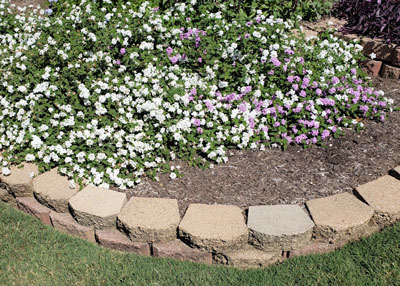
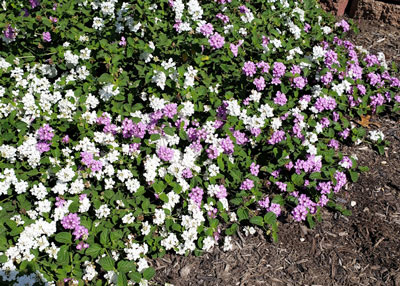
Answer: There are two possibilities. I’ll tell you how you can figure it out. The white could be a mutation. That’s probably how it was originally found. Lavender is the native color, and somewhere along the line someone found the white form and started propagating it. For a good while it was sold under the name ‘White Lightning,’ but it has never been as common as the lavender. I’m glad you found it. So, it may not be a totally stable mutation. That sort of thing happens when plants like Sunshine ligustrum and Golden euonymus revert to their mother plants’ colors.
The other possibility is that an odd cutting of lavender got stuck into the pot when the plants were propagated 18 months ago. That happens all the time. Three crape myrtle cuttings are stuck into a pot that is supposed to be red trees, but one of them ends up being white or pink. If you trace the lavender flowers, do they all come from one or two original main stems? If you decide that you don’t want any lavender, you would simply need to dig and remove them. (Then you’ll want to go in, wash your hands and forearms, and put on some hand lotion to stop the itching!)
QUESTION 3
SHOULD THESE ROSES BE PRUNED NOW?
Question: Our Knockout roses are not looking good, but not from the dreaded rosetta disease. Would you recommend a good pruning right now? Fertilization? Paula M., Mt. Vernon.
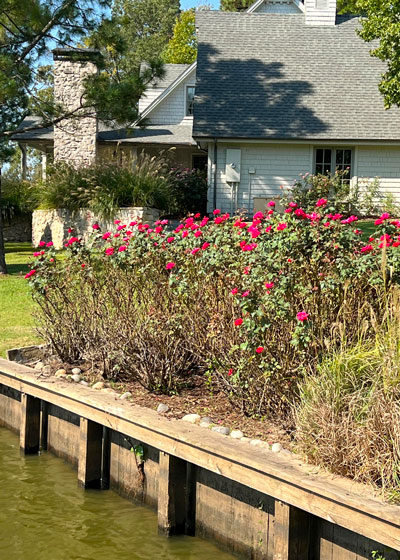
Answer: Pretty home and pretty setting.
Agreed: I do not see rose rosette virus affecting your plants, either. To me it looks more like the plants might have struggled with black spot fungus this year. That would account for all the bare stems. You need to spray regularly to lessen its outbreaks, starting as new growth begins in the spring and going into summer, then picking up again in the fall. Look for a product labeled for black spot on roses.
As for pruning and feeding, I would prune these back significantly in early February. Remove as much as 50 to 60 percent of their top growth, certainly cutting beneath the level where they were cut last spring. Trim out as much of the small, dead stubble as possible. Fertilize the plants at that same time and repeat it weekly into the summer and again in the fall. But do keep your eyes open for rose rosette virus.
QUESTION 4
WHAT IS THIS WEED, AND HOW CAN I ELIMINATE IT?
Question: I’ve been unable to identify this weed, so I don’t know how to get rid of it. It has taken over parts of my backyard where St. Augustine has died in previous years before we owned the home. Will the St. Augustine grow back? Jacob M., Plano.
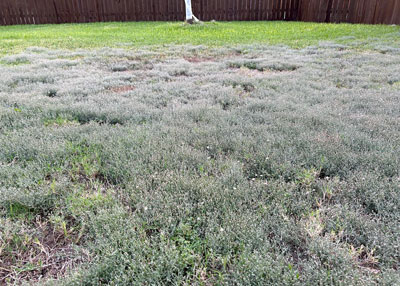
Answer: You have the densest stand of roadside asters I’ve ever seen. In a week there will be a blanket of lavender-white flowers that will cover your lawn. They will persist for a couple of weeks, then the weeds will turn to dried stubble that will puncture your feet all winter. I refer to this plant as a “weed of neglect.” I tell you that, not to offend you, but to pre-warn you in case you see or hear me use that term somewhere else. I would suggest you apply a broadleafed weedkiller containing 2,4-D as soon as possible (this weekend at the latest) to try to kill these plants before they have time to set seed for next year. Read and follow label directions carefully to avoid damage to nearby trees and shrubs. I prefer to use a 2-gal. tank sprayer for this type of herbicide.
My other suggestion (not kidding) would be to use a stout hoe that you have sharpened very well and cut these plants out. Each one has one taproot and one stem attached to it. If you angle your hoe at a 45-degree angle when the ground is moist, you can move quickly across the lawn cutting each plant with one chop. I’ve never recommended that before for this weed, but again, I’ve never seen so much of it.
Then, next spring, when the soil warms in April, cut fresh St. Augustine sod into squares 8 ins. on a side and checkerboard them across the bare areas on 16-inch centers. It will cover quickly, and it is the dominant plant if you take good care of it. Good luck. Hope that helps!
QUESTION 5
WHY WOULD JUST 1 OF MY 28 ELAEAGNUS PLANTS LOOK SICK?
Question: I have 28 elaeagnus plants that were set out 3-1/2 years ago. They have all been watered the same amount at the same time and two times per week. I don’t see any insects. Only one is looking sick. What might have caused that? James K., Quinlan, Hunt County.
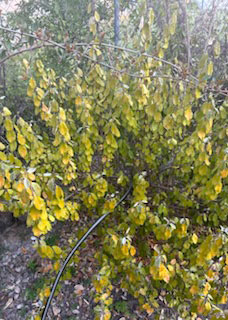
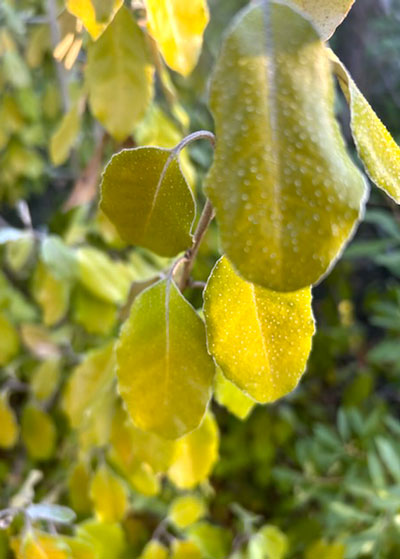
Answer: Check the way the plants have been watered. Is there any chance that this one plant’s water source might have been blocked, plugged, broken, or otherwise obstructed? Overall yellowed leaves tell us the plant “isn’t feeling well,” but they don’t give us very precise clues. That would be the first thing I would consider.
I have lost a couple of elaeagnus plants to the soil-borne fungus cotton root rot. It’s a frequent problem in the Blackland Prairie – the reason cotton production in North Central Texas has diminished so greatly. It kills elaeagnus and other susceptible trees and shrubs rapidly, usually in a matter of just a few days. Use of a sulfur soil acidifier at a high application rate can slow its spread, at least for a while. Honestly, I really hope your problem is with irrigation. It’s easier to control. If it’s cotton root rot, it’s likely to move to the plants on either side of the impacted plant. Time will tell a lot.
QUESTION 6
IS THIS ROSE ROSETTE VIRUS?
Question: My patio roses are about 4 years old. They have these odd leaves growing in spots. Is this rose rosette virus? Barbara M., Dallas.


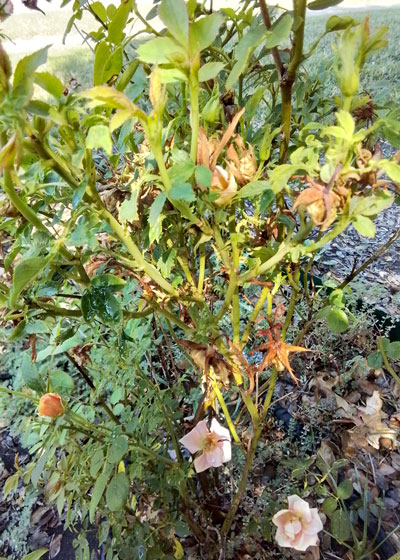
Answer: Yes. Here is the information I leave archived on my website since RRV has become so widespread across the DFW Metroplex and North Central Texas.
Things I look for in photos like yours:
• Clubby stems,
• Strong canes with both canes and leaves larger than normal (“bull” canes),
• Canes that have abnormal numbers of thorns – sometimes 10 or 20 times as many as normal
• Buds that don’t open properly,
• Plants that become stunted as entire branches turn brown and die.
I think I’m seeing almost all of those symptoms in your photos. No other issue other than RRV causes them.
Sadly, the only recourse is to dig and remove the infected plants. There is no cure or prevention for this disease. I’m sorry for the bad news. We all have faced it at one point or another.
QUESTION 7
HOW CAN I KILL WILD VIOLETS IN MY ST. AUGUSTINE LAWN?
Question: How can I kill wild violets in my St. Augustine lawn without killing the grass? Janice M., Mansfield.
Answer: It’s a variation of an answer I gave a bit earlier. Use a broadleafed weedkiller containing 2,4-D. Several brands say, “Even kills wild violets” on their labels – indication of how tough the weed is. Apply the herbicide with a pump sprayer set so the droplets are slightly larger than mist sized. Your goal is to coat the leaves of the violets without having a lot of it bead up and run off the funnel-shaped leaves. If you still see that happening, pause the spraying long enough to open the sprayer and put in one drop of liquid dishwashing detergent per gallon of mix. That will help the spray adhere to the leaves. Don’t mow for several days before or after you spray. It will take several weeks before you see the violets start to roll up their leaves and die, but it will work. You may need a second application 3 to 5 weeks later.
